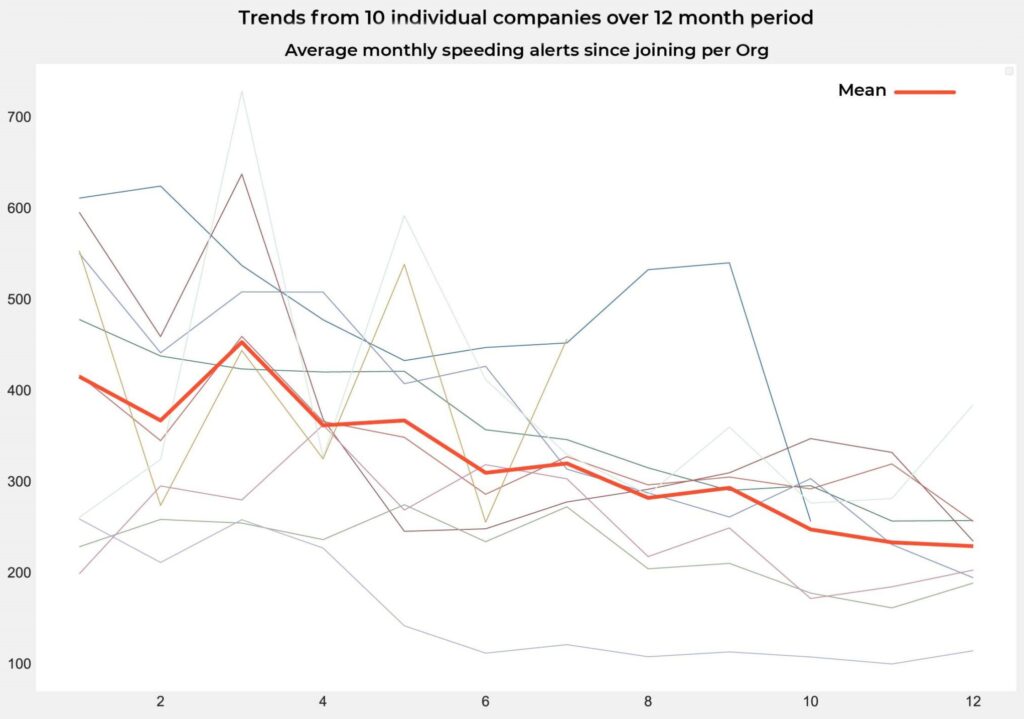The headline:
Our insights team looked at data from 10 key customers and found that over the first 12 months of a contract, the average CameraMatics user witnessed a 37% fall in harsh braking events and a 42% decrease in speeding events.
The detail:
Accidents cost money. Serious accidents cost a lot of money. That’s why CameraMatics is dedicated to stopping those accidents before they happen.
We do that in two ways:
- Driver warnings that intervene to prevent fatigue and distraction, or when a vulnerable road user is close to the vehicle. These stop accidents in the moment, by giving the driver the support he or she needs to react in time.
- Monitoring and sharing of significant driving events, that enables fleet managers to provide personalised training for drivers, which improves safety levels over time.
You get the benefit of the first approach the moment you switch on a new CameraMatics system. From the second you start to use the product, you will see these benefits. And as fatigue and distraction are such common causes of accidents, they soon add up.
The second approach takes longer, and what is why we can measure it. Broken down, that process looks something like this:
- Telematics automatically identify all instances of speeding, harsh braking and harsh cornering
- AI-powered driver monitoring detects instances of fatigue, distraction and phone usage
- Where relevant these events are automatically graded and categorised by severity and type
- Fleet managers can automatically see insights relating to these events for drivers, vehicles or event type
- Where necessary, events can be shared back with drivers for review (and with all related camera footage supplied)
The outcome of this process is simple: fleet managers can spot dangerous work practices, and drivers can learn from their own mistakes and improve over time. To give a couple of real world examples:
- A driver consistently speeding can be asked to review speeding incidents, and have the need to obey limits made clear
- A driver exhibiting consistent signs of fatigue can be supported to arrive at work fully rested, whether by addressing underlying issues or adjusting shift times in accordance with Hours of Service (HOS) regulations.
- A driver and fleet manager can collectively review a harsh braking incident and agree on what went wrong, and what needs to be corrected in future
CameraMatics goes beyond even this, however. We provide automated driver scoring, and our DriveIQ interactive learning platform gives drivers the training and support they need to improve and maintain their skills.
In total, we’re an integrated platform for the continual development and improvement of a safety culture: with the reduction in accidents that goes with it.
The results:
The process above is continuous. That means that we can measure how the number of incidents changes over time, and compare the rate one year into the contract with the same number at the start. If CameraMatics works, we should see that number coming down.
To see if that was the case, we looked at the number of alerts in each month for the first 12 months of a contract. The number of alerts per vehicle was tracked and normalized relative to mileage, in order to get a meaningful ratio of alerts per 100km, and thus minimize discrepancies and outlier behavior based on difference in driving activity between orgs and vehicles.
After performing that analysis, the results were conclusive: CameraMatics delivers significant fleet safety gains.
Let’s look at speeding incidents, which have a direct impact on accidents (speeding is the leading cause of accidents, and definitely the leading cause of serious accidents).
After 12 months, speeding incidents have declined by 42.1% across the entirety of the 10 customers analyzed, as shown in the chart below.

Even more impressively, ‘extreme’ speeding events (those in excess of 20kmh) are reduced by 58.2%, or more than half.
It is interesting to note that this change is consistent and ongoing, rather than a one off change of habits once telematics are fitted to the vehicle (in most cases telematics would have already been there anyway). Instead, it is clear evidence of the benefits of the CameraMatics approach to gradual improvement of the safety culture.
It is a similar story when we look at incidents of harsh braking. Here, conducting the same analysis indicates a decline over 12 months of 36.6%. As with speeding, harsh braking is a clear indicator of fleet safety: harsh braking incidents are usually (not always) seen as ‘near misses’ – and a good indicator of general safety levels.

So there we have it. The feedback loop works, and CameraMatics delivers continuous safety improvements across the board, and throughout the fleet. Our customers already tell us they save millions of dollars every year thanks to our systems. Here’s the proof.
Join our customers in reducing accidents and promoting safer driving across your fleet.









